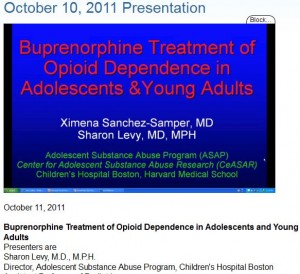Children and Addiction | Review of Opioid Addiction Video
This is a review of a video on children and addiction. We don’t really see children in methadone treatment centers, but they too have opioid problems. The original video can be located at the PCSS-B website. It covers the topic of children and addiction to physician authorized medications. It also covers children and addiction and the current treatment with the medication Suboxone.
I thought the video on children and addiction very interesting. It is aimed towards physicians who prescribe Suboxone (buprenorphine), but it is simple enough for the pubic to understand most of it. The video is about 40 minutes in length. Adding the introduction, body and Q&A it will take close to an hour to watch.
Children and Addiction Video Highlights
The lecture on children and addiction reviews the current problems with opioids in children and teens and then moves to the use of suboxone in children and young adults. Here are the main points:
Children and teens use physician authorized opioids because of several reasons. They think because these medications are prescribed by a doctor, they are not harmful. Since they observe adults using physician authorized narcotics, they think they are safe to experiment with. Finally, they think that since one doesn’t have to obtain the drug from an illegal source (you can go to a pharmacy) that they are not really “bad” and they will get into less problems using these medications. There seems to be less stigma using physician authorized pills compared to illegal drugs. All these combine to the increase the risk of children and addiction.
There has been an effort in the United Stated during the last ten years to alleviate pain better. This has caused more physician authorized drugs in the community and more children and addiction.
There were about 1 million people addicted to opiates in the year 2000. In 2006, the national survey on drug use and health indicated this number being 2.4 million.
Narcotic related admissions for 18-25 year olds doubled from 1993 to 2002.
Children and addiction comes from the fact 1 in 8 teens has tried narcotics “for fun” before completing high school. Half of the new narcotic users in 2001 were below the age of 18. 60% of teens indicate physician authorized meds are easy to get from family and others. Half of teens say narcotics are easy to buy from the internet or easy to obtain or steal from others close to them.
The USA has 4.6% of the globe’s population, but 80% of the narcotic supply is here. 99% of the globe’s hydrocodone (in Vicodin) is consumed in the States.
Following alcohol and cannabis, physician authorized opioids are the most abused drugs
Suboxone is approved for ages 16 and above. It has been used in younger children.
Daily habits of physician authorized pills initially can be purchased by a teen, but soon costs get out of control and can reach hundred’s of dollars per day. When this occurs, they begin using heroin which is more pure and cheaper and this increases the children and addiction.
In 2003, the price of narcotic addiction was 100 billion dollars
Children and Addiction | Summary
The use of opioids in children and teens continues to increase yearly. There are likely multiple causes. Children see physician authorized pills as more safe and having less of a bad name than other drugs. They don’t see how children and addiction problems progress over time and cause many problems including a high cost, risk of death from overdose, and being enslaved by the drug. Suboxone (buprenorphine) is one treatment for narcotic dependence. Suboxone can be used to successfully treat children and addiction problems at this young age.
Suboxone Treatment Directory And Methadone Treatment Directory
Dr. Rich is a Board Certified Psychiatrist with licenses in Texas and Hawaii. He specializes in the treatment of opioid addiction with buprenorphine and runs a FREE locator service to find Methadone Treatment including Suboxone treatment of oxycontin addiction. Suboxone Doctor in your area.
Dr. Rich has written more articles on the cost of oxycontin, buprenorphine (Suboxone) including frequently asked questions and a recent post : Suboxone Cost : Will Medicare and Medicaid Cover Treatment ?
Other Resources:



